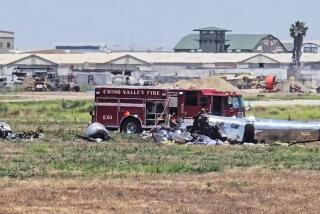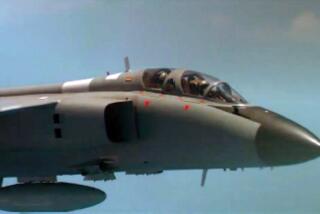U.S. Spy Plane, Chinese Fighter Collide Over Sea
BEIJING â A U.S. Navy spy plane and a Chinese fighter jet collided Sunday over the South China Sea, causing the American craft to make an emergency landing in China and the Chinese plane to crash, U.S. and Chinese officials said.
The 24 crew members aboard the EP-3 U.S. reconnaissance plane were unhurt, but U.S. defense officials said they have been unable to establish contact with the crew since the craft came to ground on Hainan island, a Chinese province off the countryâs southern coast. The pilot of the downed Chinese jet was reported missing.
American diplomats from Beijing were to arrive this morning on Hainan to press for the release of the crew and plane, but it remained unclear how the Chinese would respond. The incident puts more strain on increasingly shaky Sino-U.S. relations.
U.S. officials said they would not be able to determine responsibility for the incident until they talked to crew members. They also warned the Chinese not to enter the top-secret aircraft, which the Americans insisted was âsovereign territory.â
China blamed the U.S. for the crash, which occurred about 9:15 a.m. Sunday in China (5:15 p.m. Saturday PST).
Two Chinese F-8 fighters were conducting ânormal flight operationsâ about 65 miles southeast of Hainan when the American EP-3 suddenly veered toward one of the Chinese jets, a statement by the Chinese Foreign Ministry said.
âThe nose and left wing of the U.S. plane hit the Chinese plane and caused it to crash,â the statement said, adding that rescue crews were searching for the downed Chinese pilot.
âThe U.S. should bear full responsibility,â declared Zhu Bangzao, a Foreign Ministry spokesman.
But Adm. Dennis Blair, chief of the U.S. Pacific Command, said âcommon senseâ suggests that the lighter, faster Chinese jets caused the collision with the heavier, clumsier EP-3, which is about the size of a Boeing 737.
âBig airplanes like this fly straight and level on their path. Little airplanes zip around them,â Blair told reporters in Honolulu. âItâs pretty obvious who bumped into who. Iâm going on common sense now because I havenât talked to our crew.â
According to U.S. officials, the American craft was on a routine surveillance mission out of Kadena Air Base in Okinawa, Japan, when the two fighter jets came up alongside the EP-3 and âinterceptedâ it.
Although the intentions of the Chinese pilots were unclear, when âtwo fighter jets come up on [you], theyâre generally not coming up to say hi,â said Lt. Cmdr. Sean Kelly, a spokesman for the U.S. Pacific Command.
Kelly said the EP-3 and one of the Chinese planes bumped into each other, causing enough damage that the pilot of the American craft issued a mayday distress signal and landed the disabled plane at an airfield on Hainan.
Kelly said that under international convention, âany military aircraft is essentially sovereign territory of its owner. So it cannot either be boarded, seized or inspected without the express permission of the U.S. government.â
U.S. defense officials said they expected China to ârespect the integrity of the aircraft and the well-being and safety of the crewâ and to facilitate the repair and return of the EP-3. Beijing said âproper arrangementsâ had been made for the U.S. crew but did not say where they were.
Sundayâs collision is likely to complicate already edgy relations between Washington and Beijing, including on the military front. A few months ago, a high-level Peopleâs Liberation Army officer defected to the U.S. in an embarrassing setback for Beijing. In China, authorities have arrested two scholars with U.S. ties and charged one with spying.
This month, the Bush administration is to decide on an arms package for Taiwan, which China claims as part of its territory. Supporters of Taiwan on Capitol Hill have urged the White House to sell the island advanced weapons, including several naval destroyers, to increase its ability to fend off any attack from the mainland.
U.S. officials said the air maneuvers leading up to Sundayâs crash are not uncommon, with an intercept by Chinese planes occurring in about one of every three U.S. patrol flights along the Chinese coast. But Blair said that the intercepts âhave become more aggressiveâ over the last couple of months. The U.S. has protested about the âpattern of increasingly unsafe behaviorâ but âdid not get a satisfactory response,â he said.
U.S. Aircraft Belongs to Sophisticated Class
The collision appeared to be the first between Chinese and American military planes.
The EP-3 belongs to a sophisticated class of land-based, long-range, anti-submarine patrol aircraft. Military analysts say that it contains top-of-the-line electronic data-gathering equipment that can intercept telephone calls and e-mail as well as radar and fax data.
Military analysts said the crew members would be able to erase all data and disable the surveillance equipment if such moves were deemed necessary.
Defense officials said the U.S. military sought to contact the downed EP-3 on Sunday but was unsuccessful. Rear Adm. Craig Quigley, the Pentagonâs chief spokesman, said that could have meant that the planeâs communications gear was broken as a result of the collision or that the crew had left the plane.
Quigley said he was unaware of any policy that would require crew members to remain on a plane to guard classified equipment after a landing on foreign soil.
âWe are waiting right now for the Chinese government to give us the kind of cooperation that is expected of countries in situations like this,â Blair said. âBut as time goes on, itâs increasingly worse, and itâs been 18 hours that we donât have a phone call yet from our crew. Weâre talking about a place that has telephones.â
American Military an Irritant to Many
Some China experts predicted that the disabling of the U.S. plane would be read by many in China as a small victory against the powerful U.S. military, which is an irritant to many in the country.
Bates Gill, a China expert at the Brookings Institution in Washington, said that from Chinaâs perspective, âyouâve sent the message about intruding in airspace. You forced [the plane] to land. Youâve got your hands on it.â
Reaction in some Chinese Internet chat rooms was bellicose, echoing the angry response following the North Atlantic Treaty Organization bombing of the Chinese Embassy in Belgrade, Yugoslavia, in 1999, which set off anti-American riots across China.
âThis is another armed provocation following the bombing of our embassy,â wrote one Internet user who signed his posting as Common Man No. 689. âInterrogate the U.S. pilots, confiscate the plane, and compensate us for our losses.â
Security around the U.S. Embassy was tightened, but no untoward incidents were reported by midmorning today.
State Department officials said that on Sunday, Joseph Prueher, the U.S. ambassador to China, and Chinaâs vice foreign minister held an âinitial meeting to resolve the situation.â
A retired Navy admiral, Prueher was head of U.S. forces in the Pacific before Blair and has close knowledge of U.S. military strategy and tactics in the region.
In Washington on Sunday, State Department spokeswoman Michelle King said: âWeâve been in touch with the Chinese since last night and throughout the day. We have been assured by the Chinese government that the crew are safe and well.â
President Bush, who returned to the White House on Sunday afternoon from Camp David, was briefed on the incident shortly after it occurred, White House officials said.
âWe are monitoring the situation,â said Gordon Johndroe, a White House press aide.
U.S. military officials said it is routine for Chinaâs planes to swoop alongside American planes flying off its coast, just as it is for U.S. planes to approach foreign military aircraft that fly in airspace off the United States. The purpose is to let the visitors know that the home nation is aware of their presence, and to test reactions.
The EP-3 is about 106 feet long. In a collision, the craft has the potential to do great damage to a smaller plane. One U.S. defense official said Sundayâs collision would be akin to a crash between a BMW and an 18-wheeler truck.
Of the 24 crew members on board the EP-3, all but a pilot and co-pilot were probably in the rear of the plane, involved in the electronic eavesdropping operation, defense officials said. The group included 22 Navy personnel, plus one Marine and one Air Force service member.
The Navy plane is part of the VQ-1 electronic countermeasures squadron based at Whidbey Island Naval Air Station in Washington state.
Beijing claims a broad swath of the South China Sea as Chinese waters, but other countries dispute those claims.
Hainan island, which is close to Vietnam and the disputed Spratley Islands, is dotted with military bases.
U.S. lawmakers appearing on Sunday TV talk shows underscored the sensitivity of the matter and the impact its resolution might have on Sino-U.S. relations.
Sen. John McCain (R-Ariz.), a member of the Senate Armed Services Committee, said on NBCâs âMeet the Pressâ that the airplane âshould not be inspected or entered by any Chinese authorities because of the nature of the equipment on board.â
Noting the recent tensions over Taiwan and the Chinese crackdown on the Falun Gong spiritual movement, McCain added, âThis could be another episode in a series of problems that weâre having in our relations with China.â
âItâs obviously serious whenever a military collision like this takes place,â former Secretary of State Madeleine Albright said on CNNâs âLate Edition.â
Albright said the incident pointed to the importance of keeping diplomatic channels open with China so that incidents between the two nations âcan be dealt with quickly and peacefully.â
*
Chu reported from Beijing and Richter from Washington. Times staff writer Megan Garvey in Washington contributed to this report.
(BEGIN TEXT OF INFOBOX / INFOGRAPHIC)
Aerial Surveillance
The crew of a U.S. Navy reconnaissance plane was reported unhurt after the craft collided with a Chinese fighter jet and made an emergency landing in China, which was searching for its missing pilot. U.S. officials warned Beijing against entering the EP-3, a top-secret American aircraft like that in the photo below.
*
The plane
* Maker: Lockheed
* Size: 100-foot wingspan; 106 feet long
* Crew: Consisted of one member of the Air Force, one Marine and 22 Navy personnel; most are technicians and equipment operators.
* Engines: Four, propeller-driven
* Range: 3,450 miles
More to Read
Sign up for Essential California
The most important California stories and recommendations in your inbox every morning.
You may occasionally receive promotional content from the Los Angeles Times.












